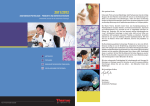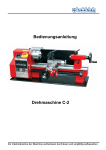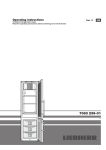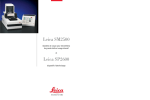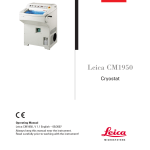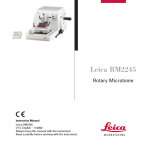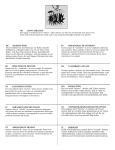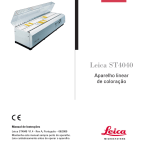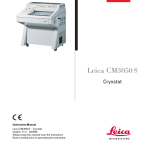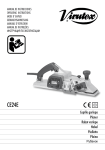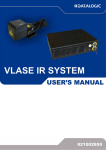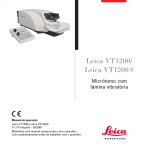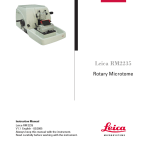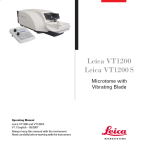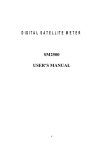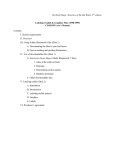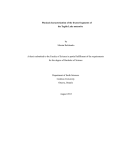Download Leica SM2500 - Leica Biosystems
Transcript
Leica SM2500 Heavy-duty sliding microtome Instruction manual Leica SM2500 V1.3 English - 10/2007 Always keep this manual near the instrument. Read carefully prior to operating the instrument. NOTE The information, numerical data, notes and value judgments contained in this manual represent the current state of scientific knowledge and stateof-the-art technology as we understand it following thorough investigation in this field. We are under no obligation to update the present manual according to the latest technical developments, nor to provide our customers with additional copies, updates etc. of this manual. For erroneous statements, drawings, technical illustrations etc. contained in this manual we exclude liability as far as permissible according to the national legal system applicable in each individual case. In particular, no liability whatsoever is accepted for any financial loss or consequential damage caused by or related to compliance with statements or other information in this manual. Statements, drawings, illustrations and other information as regards contents or technical details of the present manual are not to be considered as warranted characteristics of our products. These are determined only by the contract provisions agreed between ourselves and our customers. Leica reserves the right to change technical specifications as well as manufacturing processes without prior notice. Only in this way is it possible to continuously improve the technology and manufacturing techniques used in our products. This document is protected under copyright laws. Any copyrights of this document are retained by Leica Biosystems Nussloch GmbH. Any reproduction of text and illustrations (or of any parts thereof) by means of print, photocopy, microfiche, web cam or other methods – including any electronic systems and media – requires express prior permission in writing by Leica Biosystems Nussloch GmbH. For the instrument serial number and year of manufacture, please refer to the name plate at the back of the instrument. © Leica Biosystems Nussloch GmbH Published by: Leica Biosystems Nussloch GmbH Heidelberger Str. 17 - 19 D-69226 Nussloch Germany Telephone: +49 (0)6224 143-0 Facsimile: +49 (0)6224 143-200 Internet: http://www.histo-solutions.com Leica SM2500 3 Table of contents 1. Important information ................................................................................................................ 6 1.1 1.2 1.3 Symbols used in the text and their meanings ............................................................................................ 6 Designated use ............................................................................................................................................... 6 Information on this instruction manual ....................................................................................................... 7 2. Safety ............................................................................................................................................ 8 2.1 2.2 2.3 Safety regulations .......................................................................................................................................... 8 Built-in safety devices ................................................................................................................................... 9 Safety instructions ....................................................................................................................................... 10 3. 4. Technical data ............................................................................................................................ 13 Setup ............................................................................................................................................. 14 4.1 4.2 4.3 4.4 4.5 4.5.1 4.5.2 4.5.3 Overview - instrument parts / functions ................................................................................................... 14 Site requirements ......................................................................................................................................... 14 Standard delivery Leica SM2500 ............................................................................................................... 15 Unpacking, transport, installation .............................................................................................................. 16 Electrical connection ................................................................................................................................... 17 Verifying and adjusting the voltage selector ........................................................................................... 17 Installing power cord, accessory cords and connecting cable to the microtome ............................ 18 Connecting a remote alarm device or remote camera shutter ............................................................. 19 5. Operation ................................................................................................................................... 20 5.1 5.2 5.3 5.4 5.4.1 5.4.2 5.4.3 5.4.4 5.4.5 5.4.6 5.4.7 5.4.8 5.4.9 5.4.10 5.4.11 5.4.12 5.4.13 5.4.14 Overview of chapter 5 ‘Operation’ ............................................................................................................. 20 Switching the instrument on ....................................................................................................................... 21 Overview control panel - by functional areas .......................................................................................... 22 Description of each individual control element ....................................................................................... 24 Foot switch .................................................................................................................................................... 24 Area 1 - Standby on/off; emergency stop ................................................................................................. 25 Area 2.1 - Modes of operation .................................................................................................................... 26 Rotary-type selector switch in area 2 ....................................................................................................... 27 Area 2.2 - Section/milling thickness, section/milling stroke preselection, retraction ....................... 28 Area 2.3 - Sectioning / milling modes ........................................................................................................ 29 Area 2.4 - Sledge speed .............................................................................................................................. 30 Area 2.5 - Setting the stop or photo position ............................................................................................ 31 Area 2.5 - Changing the dwelling and triggering time in photo position .............................................. 32 Area 2.6 - Start / stop sectioning / milling ................................................................................................. 33 Area 3 - Operating optional supplementary instruments ....................................................................... 34 Area 4 - Section/milling stroke counter and thickness totalizer and reset buttons .......................... 35 Area 5.1 - Manual movement of knife / miller .......................................................................................... 36 Area 5.2 - Manual movement of the sledge ............................................................................................. 37 4 Instruction manual V 1.3 – 10/2007 Table of contents 5.5.1 5.5.2 5.5.3 5.5.4 5.5.5 5.5.6 5.5.7 5.5.8 5.5.9 5.5.10 5.5.11 5.5.12 5.5.13 5.5.14 5.6 5.6.1 5.6.2 5.6.3 5.7 Mounting the base plates ........................................................................................................................... 38 Clamping specimens or specimen stages in the base plate with vise clamp .................................... 40 Mountable jaws for vise .............................................................................................................................. 42 Mounting specimen holders onto the base plate with dovetail guide ................................................ 42 Specimen orientation ................................................................................................................................... 45 Mounting the knife holders ......................................................................................................................... 46 Inserting knives into the holders ................................................................................................................ 46 Mounting knife holder A .............................................................................................................................. 47 Mounting knife holder B .............................................................................................................................. 50 Mounting knife holder C .............................................................................................................................. 52 Fixed-setting declination blocks (45°) and knife holder A or C ............................................................. 55 Working with fixed-setting (45°) declination blocks and knife holder B ............................................. 58 Inserting the disposable blade rail (only in knife holder B) ................................................................... 59 Working with distance blocks for sectioning very high specimen blocks .......................................... 59 Working with the instrument ...................................................................................................................... 60 Switching the instrument on / selecting parameters ............................................................................. 60 Trimming ........................................................................................................................................................ 61 Sectioning ...................................................................................................................................................... 62 Switching the instrument off ...................................................................................................................... 63 6. Trouble shooting ...................................................................................................................... 64 6.1 6.2 6.3 Error codes .................................................................................................................................................... 64 Instrument / accessories not working ...................................................................................................... 64 Power failure ................................................................................................................................................. 64 7. Cleaning, disinfection and maintenance ............................................................................ 65 7.1 7.2 7.2.1 7.2.2 7.2.3 Cleaning / disinfection ................................................................................................................................. 65 Maintenance ................................................................................................................................................. 67 General maintenance steps ........................................................................................................................ 67 Replacing the fuses ...................................................................................................................................... 68 Lubricating the bearing points and the nut of the micrometer spindle ............................................... 70 8. Overview - accessories .......................................................................................................... 71 8.1 8.2 Knife holders, specimen holders, additional accessories ..................................................................... 71 Overview - which knife to be used in which knife holder ...................................................................... 73 9. 10. 11. Warranty and service .............................................................................................................. 74 EC Declaration of Conformity ................................................................................................. 75 Peoples Republic of China ..................................................................................................... 76 Leica SM2500 5 1. Important information 1.1 Symbols used in the text and their meanings Warnings and cautions appear in a grey box and are marked by a warning triangle. Failure to comply with these warnings/ cautions can lead to accidents, bodily injury and damage to instrument and/ or accessories. Notes, i.e. important information for the user, appear in a grey box and are marked by an information sign. (5) Figures in brackets refer to item numbers in illustrations or to the illustrations themselves. ENTER Function keys that need to be pressed on the control unit are printed in bold and capital letters. 1.2 Designated use Fig. 1 The Leica SM 2500 is a microprocessor-controlled, electrically driven heavy-duty sliding microtome, designated to produce thin sections of industrial materials and paraffin-, celloidin- and plastic-embedded samples in medicine, biology and industry. In connection with the Leica SP 2600 ultramilling device, the unit is used for surface milling of plastic, metal and organic-material specimens (such as bones, teeth). - The Leica SP2600 is described in a separate instruction manual. The Leica SM 2500 may be used only in conjunction with accessories and supplementary instruments made by Leica. If the instrument is used for any other than the designated application, this will be considered an improper use of the product! 6 Instruction manual V 1.3 – 10/2007 1. 1.3 Important information Information on this instruction manual Instrument type All information provided in this instruction manual applies only to the instrument type indicated on the title page. Name plates indicating the instrument type and serial number are attached to the right side of the microtome and to the left side of the control unit. Microtome Fig. 2 Control unit Fig. 3 Working with this instruction manual This manual contains important instructions and information related to the operating safety and maintenance of the instrument. It is an important part of the product, which must be read carefully prior to setting up and operating the instrument and it should be kept near the instrument at all times. If additional requirements on accident prevention and environmental protection exist in the country of operation, this instruction manual must be supplemented by appropriate instructions to ensure compliance with such requirements. Leica SM2500 7 2. Safety 2.1 Safety regulations This instrument has been built in accordance with the German version of the following directives and standards: 1. Council Directive 98/37/EC - Machinery • • • • • • • DIN EN 292-1 - Part 1 DIN EN 292-2 and A1 - Part 2 DIN EN 294 DIN EN 349 DIN EN 418 DIN EN 1037 DIN EN 1050 2. Council Directive 73/23/EEC - Low voltage • DIN EN 61010-1 • DIN EN 61010-1/A2 - Part 1 3. Council Directive 89/336/EEC - Electromagnetic compatibility • • • • • DIN EN 61326 - Amendment A1 DIN EN 61326/A1 - Amendment A1 DIN EN 61000-3-2 - Part 3 - Main section 2 DIN EN 6100-3-2 - Part 3-2 DIN EN 6100-3-3 - Part 3-3 - Main section 3 In order to maintain this condition and to ensure safe operation, the operator must observe the instructions and warnings contained in this instruction manual. 8 Instruction manual V 1.3 – 10/2007 2. 2.2 Safety Built-in safety devices The instrument is equipped with the following safety features and devices: Emergency stop button located on the control panel: • For a detailed functional description of the emergency stop switch please refer to chapter 5.4.2, page 23. Emergency stop function of the foot switch: • For a detailed functional description of the foot switch and the emergency stop function integrated into the foot switch, please refer to chapter 5.4.1, page 22. Integrated knife guards of the different knife holders • Detailed descriptions of the knife guards integrated into each knife holder are provided in chapter 5.5. The safety devices provided by the manufacturer constitute only a basis for accident prevention. Major responsibility for accident prevention during the use of the instrument rests with the employer who has the operating authority for the instrument and, in addition, with the persons, designated by him, who operate, service and repair the instrument. To ensure safe and trouble-free operation of the instrument, be sure to comply with all instructions, warning and cautions in the following chapters! Leica SM2500 9 2. Safety 2.3 Safety instructions Be sure to read and comply with the safety instructions, warnings and cautions in this chapter, even if you are already familiar with the operation and use of other Leica products. Safety instructions: Transport and installation Be sure to follow the unpacking instructions (attached to the outside of the instrument shipping crate)! When transporting the instrument, always lock the extendible handles in place by attaching the transport safety devices (white plastic blocks) - for details on how to secure the extendible handles, please refer to chapter 4.3 ‘Unpacking, transport, installation’. The instrument may only be transported in an upright position! Two people are required to lift and/or carry the instrument (instrument weight!) Be sure to comply with the site requirements (chapter 4.2)! Never remove or modify any of the safety devices installed on the instrument and/or accessories! 10 Verify the voltage selector setting: The voltage selector comes factoryadjusted to a setting of 230 V. Prior to connecting the instrument to mains, verify whether the voltage setting is correct for the mains electricity in your laboratory! Incorrect voltage selector settings can lead to severe damage to the instrument! Prior to adjusting the voltage selector, disconnect the instrument from mains! For details on verification and adjustment of the voltage selector, please refer to chapter 4.4.1 ‘Verifying and adjusting the voltage selector’. The instrument may be connected to mains only with one of the power cords supplied and only to grounded sockets! The instrument may not be operated in hazardous locations where risk of explosion exists! Extreme temperature fluctuations and high air humidity (e.g. transport, storage) may cause condensation inside the instrument. In this case, wait at least two hours before switching the instrument on. Failure to comply with this waiting period may cause severe damage to the instrument! Instruction manual V 1.3 – 10/2007 2. Safety Safety instructions: Operating the instrument The instrument may only be operated by skilled laboratory personnel. It may only be used for the designated application and operated in accordance with the instructions contained in this manual! Before mounting the knife holder make sure the bearing blocks of the microtome supporting the knife holder are clean. Carefully place the preassembled knife holder onto the microtome bearing blocks from above. Do not slide the knife holder onto the bearings to prevent the bearing surface from getting scratched. Handle microtome knives and blades with utmost care. Knife and blade edges are extremely sharp and can cause severe injuries! Wear cut-resistant safety gloves when inserting/removing the knife (see also chapter 8.1 ‘Additional accessories’). Prior to inserting the knife, always tighten one of the knife clamping screws of the knife holder to secure the knife holder in position! Make sure not to misalign the knife when tightening the knife clamping screws as this will negatively affect sectioning results! Leica SM2500 Never leave knives/disposable blades or knife holders with a knife/disposable blade inserted lying around! Always store knives in the knife case when not in use! Never place a knife on a bench with the edge facing upwards! Never try to catch a falling knife or disposable blade! Always clamp the specimen first and the knife second! Always wear protective glasses when sectioning brittle specimens! - Risk of splintering! No liquids may enter the interior of the instrument during operation! Always cover the knife edge with the knife guard during work breaks! Always remove the knife from the knife holder when finishing work! When working with the eccentric ring, NEVER try to orient the specimen - this will cause severe damage to the specimen orientation mechanism! When knife holder A or C is combined with the declination blocks, the knife guard cannot be placed over the knife edge. Therefore, use extreme caution when working with this configuration - wear cut-resistant gloves! 11 2. Safety Safety instructions: Cleaning, disinfection and maintenance Only authorized service technicians may access the internal components of the instrument for service and repair! Prior to any cleaning, disinfection or maintenance work, the instrument must be switched off and disconnected from mains! Exception: Cleaning or disinfection procedures which require the sledge to be moved. Remove both knife and specimen prior to any cleaning, disinfection or maintenance work! Wear cut-resistant safety gloves to remove the knife (see chapter 8.1 ‘Additional accessories’). No liquids may enter the interior of the instrument during cleaning, disinfection or maintenance! Clean only with a slightly moistened cleaning cloth! Disinfection only with disinfectants that allow application with a slightly moistened cloth! Do not use any solvents (e.g. xylene, acetone), any cleaners containing solvents or scouring powders for cleaning! Appropriate cleaners for the control unit / control panel and all painted surfaces: mild laboratory detergent (slightly moistened cloth)! 12 Clean the control panel only in standby mode or when the instrument is switched off. Appropriate cleaners for non-varnished metal parts (knife holders, base plates, specimen clamps): xylene substitutes, alcohol - apply with an only slightly moistened cleaning cloth! Use cleaners and disinfectants according to the safety instructions of the manufacturer and in compliance with the regulations applicable in your laboratory! Regularly check and empty the section waste trays located below the extendible carrying handles. Prior to exchanging any fuse, always switch the instrument off and unplug the mains plug. Replace defective fuses only with fuses of identical specification! Be sure to follow the instructions in chapter 7.2.2 (selecting the correct replacement fuse for each fuse holder). After replacing the line fuses doublecheck whether the correct voltage selector setting is visible. Users may carry out only the maintenance work described in chapter 7.2! Any other maintenance work must be carried out by authorized Leica service technicians. Instruction manual V 1.3 – 10/2007 3. Technical data Microtome Section thickness range ...........................................................0 μm to 1.000 μm, adjustable in 1-μm steps Total horizontal specimen stroke ....................................................................................... maximum 275 mm Total vertical knife feed ........................................................................................................................... 70 mm Knife retraction (during specimen return stroke) ...................................................................... 0 - 1,000 μm Clearance angle adjustment ............................................................................................................. 0 ° to 17 ° Knife declination - fixed setting (declination blocks = optional accessory) ....................................... 45 ° Maximum specimen size (L x W x H) ........................................................................................ 25 x 20 x 7 cm Specimen orientation (along x / y axis) ..................................................................... 4,8 ° along each axis Specimen orientation (rotability) ................................................................................. approx. +/- 3 and 90 ° Sectioning speed ................................................................... 0.5 - 100 mm/s, adjustable in 0.1-mm steps Return speed ................................................................... 0.5 - 100 mm/s, adjustable in 0.1-mm steps Manual knife movement (slow / fast) ......................................................................... 37 mm/s and 74 mm/s Manual specimen movement (slow / fast) ................................................................. 37 mm/s and 74 mm/s Electrical connections Nominal voltage .............................................................................................................. 100 / 120 / 230 / 240 V Nominal frequency ................................................................................................................... 50 Hz and 60 Hz Maximum power draw ......................................................................................................................... 1,400 VA Main fuses, type MDA, Fa. Bussmann .............................................................................................. 2 x T10A Protective class .................................................................................................................................................. I Overvoltage installation category ................................................................................................................... II Vacuum cleaner ........................................................................ 100 / 120 V - maximum power draw 500 VA Vacuum cleaner ..................................................................... 230 / 240 V - maximum power draw 1,200 VA Lamp .......................................................................................... 100 / 120 V - maximum power draw 100 W Lamp .......................................................................................... 230 / 240 V - maximum power draw 200 W Dimensions and weights Microtome (H x W x L) ....................................................................................................... 250 x 390 x 750 mm Control unit (H x W x D) ...................................................................................................... 220 x 385 x 510 mm Required bench top space for microtome and control unit ................................................ 1,000 x 950 mm Microtome ..................................................................................................................................... approx. 75 kg Control unit .................................................................................................................................... approx. 23 kg Leica SM2500 13 4. 4.1 Setup Overview - instrument parts / functions 1.3 1.2 1.1 1 2 2.1 2.2 Fig. 3a 1.4 1. Leica SM2500 - Microtome 1.1 Knife holder system (not part of standard delivery) 1.2 Specimen holder system (not part of standard delivery) 1.3 Carrying handle, rear (extendible - not visible in Fig. 3a) 1.4 Carrying handle, front (extendible) 4.2 2. Leica SM2500 - control unit 2.1 Control unit 2.2 Emergency stop button 3. Foot switch (not visible in Fig. 3a see chapter 5.4.1 for details) Site requirements • Bench top surface for microtome and control unit sized approx. 1,000 x 950 mm • Stable laboratory bench (total weight of microtome and control unit approx. 100 kg), exactly horizontal or horizontally adjustable. • At least 15 cm space on all sides of both instruments to ensure that air can circulate freely around the instruments. • Virtually vibration-free floor. • Stable ambient temperature between +18 °C and +35 °C. • Relative air humidity of maximum 60 %, non-condensing. • Do not place near sources of vibration, avoid exposure to direct sunlight and marked temperature fluctuations. 14 Instruction manual V 1.3 – 10/2007 4. 4.2 Setup Standard delivery Leica SM 2500 1 Basic instrument 1 Separate control unit ............................................................................. 0405 42863 1 Connecting cable for control unit ........................................................ 0405 35685 1 Foot switch (0505 33888) 1 Set of power cords: -1 Power cord “D” ............................................................................... 0411 13558 -1 Power cord “USA-C-J” .................................................................. 0411 13559 -1 Power cord “UK” ST/BU F-5A ....................................................... 0411 27822 1 Set of adapter cables: -2 Adapter cables “USA” ................................................................... 0411 36234 -2 Adpater cables “EU” ...................................................................... 0411 36235 1 Set of replacement fuses: -2 x T 1.0 A ............................................................................................ 6943 01001 -2 x T 6.25A ........................................................................................... 6943 06251 -2 x T 10.0 A .......................................................................................... 6943 10001 1 Tool set: -1 Allen key, size 2.5 ............................................................................ 0194 13195 -1 Allen key, size 3.0 ............................................................................ 0194 04764 -1 Allen key, size 4.0 ............................................................................ 0194 04782 -1 Allen key, size 5.0 ............................................................................ 0194 04760 -1 Allen key, size 8.0 ............................................................................ 0194 04792 -1 Torque wrench, size 32 .................................................................. 0383 11934 -1 Single-head wrench, size 13 ......................................................... 0330 11936 -1 Screw driver .................................................................................... 0170 12988 -1 Clamping device .............................................................................. 0383 32392 -1 Remote alarm jack 6.3 mm ............................................................. 6844 01005 -1 Jack connector 3-contact ............................................................. 6844 01008 1 Brush ........................................................................................................ 0183 04477 1 Grease gun .............................................................................................. 0383 11896 1 Dust cover for microtome ..................................................................... 0212 11725 1 Dust cover for control unit .................................................................... 0212 36428 1 Rubber mat .............................................................................................. 0405 36405 1 Instruction manual for Leica SM2500 ................................................. 0701 35100 Specimen and knife holder systems are not included in the instrument standard delivery. They have to be ordered separately, in accordance with each user’s specific application(s). Mounting instructions for all accessories can be found in chapter 5.5 of this instruction manual. Leica SM2500 15 4. Setup 4.4 Unpacking, transport, installation Be sure to follow the unpacking instructions (attached to the outside of the instrument shipping crate)! 2 2 1 When transporting the instrument, always lock the extendible carrying handles in place by attaching the transport safety devices (white plastic blocks)! 1 3 Fig. 4 4 • Pull out the carrying handles (1) at the front and rear of the instrument. • Remove the upper housing parts (2) at the front and rear. • Secure the carrying handles (1) placing the white plastic blocks (3) on the telescopic bars (4). Two persons are needed to lift and/or carry the instrument (instrument weight!). The instrument may only be transported in an upright position! • Once the instrument has been placed onto the bench, remove the two plastic blocks (3) from the telescopic bars (4) and put them back into their storage place in the instrument housing. • Put the upper housing parts (2) back in place and push the carrying handles (1) inwards as far they will go. Fig. 5 Prior to connecting the instrument to mains, verify whether the voltage setting is correct for the mains electricity in your lab (please refer to chapter 4.4.1 ‘Verifying and adjusting the voltage selector’)! The instrument may not be operated in hazardous locations where risk of explosion exists! Never remove or modify any of the safety devices installed on the instrument and/or accessories! 3 16 4 Fig. 6 Instruction manual V 1.3 – 10/2007 4. 4.5 Setup Electrical connection 4.5.1 Verifying and adjusting the voltage selector The voltage selector comes factory-adjusted to a setting of 230 V. Prior to connecting the instrument to mains, verify whether the voltage setting is correct for the mains electricity in your lab! Incorrect voltage selector settings can lead to severe damage to the instrument! Prior to adjusting the voltage selector, disconnect the instrument from mains! 1 3 4 2 1 Checking the voltage selector setting: The voltage selector is located above the mains switch, on the rear left of the control unit. • Does the selected setting (1) correspond to the nominal voltage in your laboratory? • If yes: --> proceed to chapter 4.4.2 on the following page. • If no: --> the voltage selector must be changed to the correct setting as follows: • Insert a small screw driver into the notch at the lower end of the voltage selector housing and carefully remove the housing, using the screwdriver as a lever. • Remove housing (2) together with fuses (3) and the voltage selector block (4) (white color). • Remove the fuses. • Remove the voltage selector block and re-insert it so that the correct setting, corresponding to the mains voltage in your lab, is visible in window (1). (Selectable voltage settings: 100, 120, 230 and 240 V). • Re-insert the fuses. • Re-insert the housing together with the voltage selector block and the fuses into the instrument and push slightly inwards until the voltage selector housing locks in place (audible click). • Verify once again, whether the setting that shows in window (1) is appropriate for the mains voltage in your lab. Fig.7 Leica SM2500 17 4. Setup 4.5.2 Installing power cord, accessory cords and connecting cable to the microtome At the rear of the control unit, set up the following connections: • Remove the tape from the mains inlet for the power cord (8). • From the set of power cords delivered (the instrument is delivered with several, country-specific power cords), select the one that is appropriate for your lab; connect the power cord. Fig. 8 Do not yet plug the power cord into the mains outlet. Connect the remaining cables: 5 1 2 3 4 6 7 8 Fig. 9• Install the connecting cable (1) leading to the microtome and tighten the fixing screws. • Connect the other end of cable (1) to the right side of the microtome and tighten the fixing screws. • The connecting cable to the ultramiller (2) needs to be installed only when working with the Leica SP2600 --> see separate instruction manual Leica SP2600. • Connect photo camera (3) (optional). • Connect remote alarm (4) (optional). • Connect foot switch (5) (NOT optional). The foot switch must be connected - otherwise the instrument will not be operational. • Connect the vacuum cleaner (6) (optional with Leica SM2500 - necessary when working with Leica SP2600). • Connect the lamp (7) (optional). 18 Instruction manual V 1.3 – 10/2007 4. Setup 4.5.3 Connecting a remote alarm device or remote camera shutter Connecting a remote alarm device: A remote alarm device can be connected to the Leica SM2500 via a 6.3 mmdiameter jack connector (optional accessory). • For details on how to connect a remote alarm device to the Leica SM2500, please contact your local Leica office or the manufacturer Leica Biosystems Nussloch directly. Connecting a camera shutter: The Leica SM2500 offers the option to automatically trigger a photocamera shutter each time the specimen sledge reaches a preselected photo position. The connecting cable leading from the camera to the Leica SM2500 must be configured individually, depending on the type of camera used. • For on this option, please contact your local Leica office or the manufacturer Leica Biosystems Nussloch directly. Leica SM2500 19 5. Operation 5.1 Overview of chapter 5 ‘Operation’ Chapter 5 ‘Operation’ is structured as follows: Chapter 5.1 Structural description of chapter 5. Chapter 5.2 Switching the instrument on. Chapter 5.3 Overview - control panel. Chapter 5.4 Detailed description of each individual control element (controls numbered from 1 to 62; control panel divided into functional areas 1 to 5). Chapter 5.5 Mounting the accessories (specimen holders, knife holders, knives). Chapter 5.6 Working with the instrument: short description of a typical application, including references to detailed descriptions of individual steps given in other chapters. Chapter 5.7 Switching the instrument off Initial operation: The first time you operate the instrument we recommend you work through chapters 5.1, 5.2, 5.4 and 5.5, in that order. Pay particular attention to the safety instructions. Once you are familiar with the control panel functions and know how to install the accessories, proceed to chapters 5.6 / 5.7. Daily routine work: The control panel overview (chapter 5.3 on pages 20/21) will be a useful tool for your daily routine work. 20 Instruction manual V 1.3 – 10/2007 5. 5.2 Operation Switching the instrument on Caution: Did you verify whether the voltage selector is set correctly? If not, please refer to chapter 4.4.1! Incorrect voltage selector settings can lead to severe damage to the instrument! The instrument may be connected to mains only with one of the power cords supplied and only to grounded sockets! The instrument may not be operated in hazardous locations where risk of explosion exists! Extreme temperature fluctuations and high air humidity (transport, storage) may cause condensation inside the instrument. In this case, wait at least two hours before switching the instrument on. Failure to comply with this waiting period may cause severe damage to the instrument! • Switch on the mains switch (0/I) located at the rear side of the control panel (On = switch position ‘I’): All control elements on the control unit will emit light for about 2 secs. Next, the software version is displayed in the section counter (no. 44, upper display in functional area 4 - chapter 5.4.12). Fig. 10 After switching on the mains switch, the instrument will go to standby mode (mains voltage is supplied to the control unit, the control panel is, however, deactivated). • To activate the control panel, press and hold the STANDBY button for approx. 3 secs: the control elements are activated. Control parameters stored prior to switching the instrument off will still be available when the instrument is switched on again. Leica SM2500 21 5. Operation 5.3 Overview control panel - by functional areas Area 3 - includes the controls for the supplementary instruments and accessories that can be attached to the Leica SM 2500, (ultramilling attachment, vacuum cleaner, lamp). (41) Rotational speed of miller (RPM) (33/34) Lamp On/Off (35/36) Vacuum cleaner On/Off Fig. 11 (40, 39) to set rotational speed of miller (40) (37/38) Miller rotation On/Off (39) (44) Section / milling stroke counter Area 4 contains two displays: -Section counter (total number of sections / milling strokes) -Section thickness totalizer (total thickness of sections / milling strokes) Contains two reset buttons, one for each display. (42) Reset for counter (44) (43) Reset for counter (45) (45/46) Section thickness / milling stroke thickness totalizer Area 5.1 contains all display elements and control buttons for manual movement of knife / miller (operational in manual mode of operation ‘MAN’). (47) - LED (53) - LED (54) - LED (55) - LED (48) - Knife/miller fast upwards (56) (49) - Knife/miller slow upwards (57) (50) - Knife/miller slow downwards (58) (51) - Knife/miller fast downwards (59) (52) - LED (61/62) - Sectioning / milling stroke limit (56 - 59) - Manual sledge movement (forward/backward / fast / slow) (60) - LED Area 5.2 contains the display and control elements for manual movement of the specimen (in manual mode of operation ‘MAN’) and for limiting the sectioning / milling stroke length (‘Sectioning window’). Fig. 12 22 Instruction manual V 1.3 – 10/2007 5. Operation Area 1 - to switch from standby mode to active mode (control panel activated) and back. Emergency stop button, stops all instrument functions immediately when pressed. (1) LED (2) Standby On/Off Area 2.1to select a mode of operation via button (5): manual mode ‘MAN’ (6) automatic mode ‘AUTO’ (7) (5) and (6) program mode ‘PROG’ (8) (7) (8) Area 2.3(15) to select a sectioning / milling mode via button (15): continuous mode (16) single mode (17) or step-by-step mode (18) (16) (17) (18) Area 2.5 to select a stop position (24/25) or photo position (27/28), where the sledge will stop. (24) (3) LED (4) Emergency stop button (12) (11) (13) (10) (14) (20) (22) (21) (19) Area 2.2selection (10) and indication (14) of section/milling thickness (11), preselected number of sections / milling strokes (12) (in mode of operation PROG only) and knife retraction (13). Area 2.4to select (19) and indicate (22) sectioning / milling speed (20) and return stroke speed (21) of the sledge (25) (27) (9) (28) Rotary-type selector switch (9) for entering parameters (11), (12) and( 13) in area 2.2 as well as for entering parameters (20) and (21) in area 2.4. (23) Selector button ‘Stop position’ (26) Selector button ‘Photo position’ Area 2.6 contains the buttons to start and stop sectioning / milling and the LEDs that indicate sectioning / milling status. (29) (30) (32) (31) Fig. 13 To start: press (29) and (30) simultaneously To stop: press either (29) or (30) Leica SM2500 23 5. Operation 5.4 Description of each individual control element 5.4.1 Foot switch Fig. 14 The foot switch has two different functions: 1 Start / stop sectioning / milling. The foot switch can be used as an alternative to the RUN STOP + RUN ENABLE buttons (--> see area 2.6, chapter 5.4.10) so start / stop sectioning / milling. - To start, lightly press the foot switch. - To stop, once again lightly press the foot switch. 2 Emergency stop. In addition to the emergency stop button (see area 1, chapter 5.4.2), the emergency stop can be activated via the foot switch: - Press foot switch once forcefully: emergency stop function is activated. POWER (green) and E-STOP (red) on the control emit light. As soon as the foot switch is released the emergency lock is automatically unlocked and the instrument can be restarted. E-STOP (red) on the control panel goes off. 24 Instruction manual V 1.3 – 10/2007 5. Operation 5.4.2 Area 1 - Standby on/off; emergency stop 1 2 3 4 Fig. 15 1 POWER (LED) Emits light (green) when the instrument mains switch in ON. 2 STANDBY (button) Pressing this button switches the standby mode on/off. Press and hold button for approx. 3 secs to switch from standby mode to active mode and vice versa. 3 E-STOP (LED) Emits light (red), when the emergency stop button has been pressed or if the foot switch is not connected at all / not properly connected. 4 Emergency stop (button) Pressing this button immediately stops all instrument functions and movements. LEDs ‘E-STOP’ and ‘POWER’ start emitting light. All settings (modes of operation, set values and counter readings) remain stored and can be reaccessed when the instrument is switched back on. Unlocking the emergency stop / switching the instrument back on: 1. Turn the red button in direction of the arrow until it unlocks: LED E-STOP goes off. 2 Select a mode of operation (MAN / AUTO / PROG) --> see area 2.1, chapter 5.4.3. 3. If mode of operation = AUTO: select also a sectioning / milling mode --> see area 2.3, chapter 5.4.6. Leica SM2500 25 5. Operation 5.4.3 Area 2.1 - Modes of operation 5 RUN MODE (button) Press RUN MODE to select one of the operation modes below. 6 5 Fig. 16 7 8 6 MAN (LED) Emits light, when manual mode of operation MAN has been selected. In MAN mode, area 5 is activated: - Knife (or miller) and sledge can be moved manually (e.g. for bringing the knife closer to the specimen). - Sectioning / milling stroke limit (‘window’) can be defined. - Section / milling thickness, retraction (area 2.2), sectioning / milling speed as well as sledge return speed (area 2.4) can be selected. 7 AUTO (LED) Emits light, when automatic mode of operation AUTO has been selected. - Sectioning / milling mode (area 2.3) can be selected. - Parameter selection in areas 2.2 and 2.4 as in MAN. - Pressing RUN/STOP + RUN/ENABLE (or lightly pressing the foot switch) in AUTO mode starts sectioning / milling (push to start / push to stop). 8 PROG (LED) Emits light, when program mode of operation PROG has been selected. - Parameter selection in areas 2.2 and 2.4 as in AUTO and MAN. Additional features of PROG mode: Preselection of a specific number ‘n’ of sections / milling strokes to be done (LED (12) in area 2.2). - Sectioning / milling in PROG mode (press RUN/STOP + RUN/ENABLE or activate foot switch): the preselected number of sections / milling strokes is carried out as per the parameters defined (number of sections, section thickness etc.); then the sledge stops in the defined stop position (area 2.5) and an acoustic signal indicates the end of the sectioning program. Parameters selected always remain stored until new parameters are entered (also when the instrument mains switch (0/I) is switched off). 26 Instruction manual V 1.3 – 10/2007 5. Operation 5.4.4 Rotary-type selector switch in area 2 9 9 The parameters in areas 2.2 and 2.4 are entered via the rotary selector switch no. 9: - Sectioning / milling thickness in μm (section / milling feed via knife / miller) - Preselection of number of sections / milling strokes (to be carried out in ‘PROG’ mode) Fig. 17 - Retraction in μm (= knife / miller retraction during specimen return stroke) - Sledge speed - forward (= sectioning / milling speed) - Sledge speed - backward (= return stroke speed) Leica SM2500 27 5. Operation 5.4.5 Area 2.2 - Section/milling thickness, section/milling stroke preselection, retraction 12 11 14 10 Fig. 18 13 10 SET (button) Press SET to activate indication of FEED, n or RETRACT: LED starts emitting light. For entering new parameters with selector switch (9), press and hold SET until the corresponding LED starts blinking. 11 FEED (LED) When LED FEED is blinking: rotate switch (9) to enter a section/milling thickness from 0 μm (knife / miller feed off) to 1,000 μm (selectable in 1-μm steps). 12 n (LED) When LED n is blinking and PROG mode is activated: rotate switch (9) to preselect the number of sections / milling strokes to be carried out (from 1 to 1,000). 13 RETRACT (LED) When LED RETRACT is blinking: rotate switch (9) to enter a setting between 0 μm (retraction switched off) to 1,000 μm (selectable in 1-μm steps). In AUTO and PROG mode, the knife / miller is lifted away from the specimen surface at the end of each section / milling stroke (retraction). The knife / miller then stays in retraction position over the entire length of the sledge return stroke. When the retraction feature is activated (retraction value >0), RETRACT in area 5.2 emits light while the sledge is in return stroke. When the sledge reaches the front end position, the knife / miller is lowered back towards the specimen by the selected retraction value. 14 Indication of section/milling thickness, section/milling stroke preselection or retraction parameters that have been entered via rotary switch (9). - All parameters are displayed flush right. All parameters are stored automatically upon entry (no confirmation necessary) and remain stored until new settings are entered. The LEDs stop blinking automatically after a few seconds. 28 Instruction manual V 1.3 – 10/2007 5. Operation 5.4.6 Area 2.3 - Sectioning / milling modes To be able to select a sectioning / milling mode, mode of operation AUTO (area 2.1) must be activated first. 16 15 CUT MODE (button) Press button (15) to select a sectioning / milling mode. Fig. 19 17 18 15 16 CONT (LED) Emits light, when continuous mode of operation ‘CONT’ has been selected: In continuous mode, sectioning / milling starts when RUN STOP + RUN ENABLE or the foot switch are pressed and continues until RUN STOP or RUN ENABLE or the foot switch are pressed once again. 17 SINGLE (LED) Emits light, when single-stroke mode of operation ‘SINGLE’ has been selected: When RUN STOP + RUN ENABLE or the foot switch are pressed in single-stroke mode of operation, the instrument carries out one section / milling stroke and then stops in the preselected stop position. 18 STEP (LED) Emits light, when step-by-step mode of operation ‘STEP’ has been selected: in step-by-step mode, the instrument will section / mill only as long as RUN STOP + RUN ENABLE are pressed and held. Leica SM2500 29 5. Operation 5.4.7 Area 2.4 - Sledge speed 20 22 19 Fig. 20 21 19 SPEED (button) To set the cutting or return speed, press and hold the SPEED button until the corresponding LED blinks. Enter speed using the rotary button (9). 20 CUT (LED) Press and hold SPEED until the LED CUT starts blinking. Then enter the desired sectioning / milling speed of the sledge via selector switch (9) (selectable speeds: 0.5 - 100 mm/sec, in 0.1-mm steps). 21 RETURN (LED) Press and hold SPEED until the LED RETURN starts blinking. Then enter the desired return stroke speed of the sledge via selector switch (9) (selectable speeds: 0.5 - 100 mm/sec, in 0.1-mm steps). 22 Speed indication Indicates sledge speed during sectioning / milling stroke and return stroke. CUT and RETURN can be changed while sectioning / milling is in progress. All settings entered are automatically stored upon entry. No additional confirmation is required. The LEDs stop blinking automatically after a few seconds. 30 Instruction manual V 1.3 – 10/2007 5. Operation 5.4.8 Area 2.5 - Setting the stop or photo position 23 STOP POS (button) Press STOP POS to select one of the two stop positions available. 23 24 FRONT (LED) Starts emitting light when the sledge stops in the front stop position. 24 25 27 25 REAR (LED) Starts emitting light when the sledge stops in the rear stop position. 28 Fig. 21 26 26 Photo position (button) Press the Photo position button to select one of the two photo positions available. 27 PHOTO F (LED) Starts emitting light when the sledge stops in the front photo position. 28 PHOTO R (LED) Starts emitting light when the sledge stops in the rear photo position. You may either select a stop position or a photo position. When a photo position has been selected, there cannot be selected a stop position and vice versa. Leica SM2500 31 5. Operation 5.4.9 Area 2.5 - Changing the dwelling and triggering time in photo position Changing the dwelling time in photo position: - While switching on the instrument mains switch (rear of control panel) simultaneously press and hold the STOP POS button (in area 2.5) until the instrument initialization phase has been completed. - The ‘rpm’ display (area 3) will read the currently selected dwelling time in seconds. - Press the ‘+’ or ‘-’ buttons below the ‘rpm’ display to select a new dwelling time (time the sledge will remain in photo position before the photograph is taken) from 0 secs to 25 secs (in 100-ms steps). (A minus sign will be displayed in ∑ n (area 4 - see chapter 5.4.12) while you are entering your selection). Fig. 22 - To store the selected setting, press STANDBY (area 1): The ‘rpm’ indication in area 3 goes off - the selected value is stored. Fig. 23 Changing the triggering time (= exposure time): - Same procedure as when changing the dwelling time. Instead of STOP POS, press and hold the Photo position button (in area 2.5) while switching on the instrument mains switch. - Just like the dwelling time, a triggering time from 0 secs to 25 secs can be selected. The figure ‘1’ will be indicated in display ∑ n (area 4 - see chapter 5.4.12) while you enter your selection. - To store the selected setting, press STANDBY (area 1): as soon as the ‘rpm’ indication in area 3 goes off the selected value is stored. 32 Instruction manual V 1.3 – 10/2007 5. Operation 5.4.10 Area 2.6 - Start / stop sectioning / milling 31 32 29 30 Fig. 24 29 RUN STOP (button) 30 RUN ENABLE (button) 31 RUN (LED) 32 STOP (LED) Start: Press RUN STOP and RUN ENABLE simultaneously: - sectioning / milling is activated. LED RUN will be emitting light while sectioning / milling is in progress. + Stop: or Press either RUN STOP or RUN ENABLE: - sectioning / milling movement is stopped. LED STOP will start emitting light, once sectioning / milling has stopped. After you have pressed RUN STOP or RUN ENABLE or the foot switch, the instrument will complete the sectioning/milling stroke in progress before stopping in the stop (or photo) position selected. Instead of using the RUN STOP / RUN ENABLE buttons, sectioning / milling may be started / stopped as well via the foot switch (see chapter 5.4.1 ‘Foot switch’). Leica SM2500 33 5. Operation 5.4.11 Area 3 - Operating optional supplementary instruments 34 41 33 36 40 39 37 38 35 Fig. 25 33 Lamp (button) Switching the lamp on/off (lamp is not part of standard delivery). 34 LED - starts emitting light when lamp button is switched on. 35 Vacuum cleaner (button) Switching the vacuum cleaner on/off (vacuum cleaner is not part of standard delivery). 36 LED - starts emitting light when vacuum cleaner button is switched on. 37 Miller (button) Switching the rotational movement of the ultramilling attachment Leica SP2600 on/off (separate supplementary instrument - not part of Leica SM 2500 standard delivery). 38 LED - starts emitting light when ultramiller button is switched on. 39 ‘+’ button (rotational speed of miller in RPM) Press ‘+’ to increase the rotational speed of the ultramiller in steps of 100 (from 500 to 3.000 RPM). 40 ‘-’ button (rotational speed of miller in RPM) Press ‘-’ to decrease the rotational speed of the ultramiller in steps of 100 (from 500 to 3.000 RPM). 41 Rotational speed of miller (display) Shows the currently selected rotational speed of the ultramiller. 34 Instruction manual V 1.3 – 10/2007 5. Operation 5.4.12 Area 4 - Section/milling stroke counter and thickness totalizer and reset buttons 44 45 46 42 43 Fig. 26 42 CLEAR (button) - reset button for the section / milling stroke counter. Pressing CLEAR resets counter (44) to ‘0’. 44 ∑ n Section / milling stroke counter. Displays the total number of sections (or milling strokes) made since the last reset. 43 CLEAR (button) - reset button for the section / milling thickness totalizer. Pressing CLEAR resets counter (45) to ‘0’. By resetting the totalizer (45) to ‘0’ you can define any level of the specimen as ‘zero’ thickness (e.g. after a specimen has been milled until it is exactly horizontal). This feature gives you exact control on how much specimen material (thickness) is removed from a defined point ‘zero’ onwards. In addition, it enables you to go back to exactly the same vertical knife / miller position after a manual upward movement (see area 5.1, chapter 5.4.13) of the knife / miller, i.e. after moving to a vertical position of knife / miller < 0. Vertical position < 0 45 Display ∑ μm - section / milling thickness totalizer. Shows the total thickness of all sections / milling strokes carried out since the last reset. Knife ‘0’ 123456789012 123456789012 123456789012 123456789012 Specimen 123456789012 block 123456789012 123456789012 Vertical position > 0 46 LED - indicates vertical position of knife/miller, relative to the selected ‘zero’ point, during manual movement (see area 5.1, chapter 5.4.13): • Knife / miller in vertical position > 0 = knife / miller moving from ‘zero’ downwards, towards the specimen surface: LED does not emit light. • Knife / miller in vertical position < 0 = knife / miller moving from ‘zero’ upwards, away from the specimen surface: LED emitting light. Fig. 27 Leica SM2500 35 5. Operation 5.4.13 Area 5.1 - Manual movement of knife / miller 47 UP (LED) Flashing during fast upward movement of the knife / miller. LED stays lit as soon as the upper end position has been reached. 47 48 Knife / miller fast upwards (button) Press button (48) for fast upward movement of the knife / miller: The knife / miller will keep moving upwards until reaching the upper limit stop or until button (48) is pressed once again. 48 49 49 Knife / miller slow upwards (button) Press button (49) for slow upward movement of the knife / miller. Knife / miller will move upwards only as long as button (49) is held. 50 50 Knife / miller slow downwards (button) Press button (50) for slow downward movement of the knife / miller. Knife / miller will move downwards only as long as button (50) is held. 51 52 Fig. 28 51 Knife / miller fast downwards (button) Press button (51) for fast downward movement of the knife / miller. Knife / miller will move downwards only as long as button (51) is held. 52 DOWN (LED) Starts emitting light, when knife / miller has reached the lower limit stop position. 36 Instruction manual V 1.3 – 10/2007 5. Operation 5.4.14 Area 5.2 - Manual movement of the sledge 57 55 56 58 60 59 53 MAN (LED) Lit in manual mode of operation. - LED MAN must be on in order to be able to access/activate the control buttons in area 5. 54 RETRACT (LED) Lit (also when retraction = 0) while the specimen sledge is in return stroke 54 see also area 2.2 ‘Setting the retraction parameters’. 53 55 CUT (LED) Starts emitting light when the sledge reaches the rear limit position (sledge being moved via buttons (56/57)). 56 Sledge fast forward (button) Sledge moves only while the button is being held. 57 Sledge slow forward (button) Sledge moves only while the button is being held. 58 Sledge slow backward (button) Sledge moves only while the button is being held. 59 Sledge fast backward (button) Sledge moves only while the button is being held. 60 RETURN (LED) Starts emitting light when the sledge reaches the front limit position (sledge being moved via buttons (58/59)). 61 Sectioning/milling window (limitation of the sectioning/milling stroke) Setting the sectioning window: - Move the sledge to the first limit position you wish to set (use buttons 56 - 59). - Press and hold button (61) until LED (62) starts flashing - then move the sledge on to the second desired limit position. - Press and hold button (61) once again, until LED (62) stays lit, thus indicating that both positions have been stored. Fig. 29 Deleting the sectioning window: Press and hold button (61) just once until the LED starts flashing - the 61 62 instrument will return to maximum sledge stroke length as soon as the LED stops flashing after a few seconds. 62 LED ‘Sectioning / milling window’ in button (61): - Flashes - while the sectioning window is being set. - Stays lit - when a sectioning window has been defined. - Off - when no sectioning window has been defined. The sectioning window settings cannot be changed while sectioning/milling is in progress; changes are possible only in MAN mode. Leica SM2500 37 5. Operation 5.5 Mounting the accessories Always clamp the specimen first and the knife second! 5.5.1 Mounting the base plates Base plate with vise and base plate with dovetail guide are mounted the same way. Shown here is the base plate with vise. Preparing the base plate • Insert the clamping device (1) into the two notches on the underside of the base plate (base plate and clamping device are delivered separately). • Turn approx. 45° while pressing slightly downwards - until the clamping device locks in place. The clamping device can be turned 90° to a second locking position, so that the base plate can be mounted onto the sledge in two positions: • with the dovetail guide or vise at right angles to the sledge direction; • with the dovetail guide or vise in longitudinal direction. • To turn, press the clamping device slightly downwards, turn 90° and let go - it will lock in place automatically. 1 Fig. 30 1 Fig. 31 Fig. 32 1 Fig. 33 38 Instruction manual V 1.3 – 10/2007 5. Mounting the base plate onto the sledge • Remove the lid (1) from the sledge. • Position the sledge about 3 cm away from the front limit position: In front, there must be enough space to easily place torque wrench (8) on eccentric bush (2). The microtome spindle must not be visible in opening (3). • Pull eccentric bush (2) forward until the red ring becomes visible and the red line is on top. • If desired, insert eccentric ring (4) (plane side facing upwards!). 1 Fig. 34 3 The eccentric ring blocks the orientation mechanism to ensure the sectioning plane is not altered. 2 Fig. 34a Eccentric ring - optional! Caution! When working with the eccentric ring, NEVER attempt to orient the specimen, as this would severely damage the specimen orientation mechanism! - See also chapt. 5 ‘Specimen orientation’. 4 Fig. 35 5 • 6 7 • • • 2 • Fig. 36 • 8 Operation Insert clamping device (6) of base plate (5) vertically into opening (3). Lock centering pin (7) into place (tilt slightly). Push eccentric bush (2) inwards as far as it will go (red line must be on top). Turn eccentric bush (2) clockwise until the green line is on top. Place torque wrench (8) (size 32) on the eccentric bush (with the arrow pointing to the right). Turn torque wrench clockwise until a slight click can be heard and felt (= tightening torque of 45 Nm). DO NOT TURN ANY FURTHER, to prevent the thread of the eccentric bush from being stripped! Fig. 37 Leica SM2500 39 5. Operation 5.5.2 Clamping specimens or specimen stages in the base plate with vise clamp In the base plate with vise you can either directly clamp specimen blocks or specimen stages holding specimen embeddings. 2 1 Fig. 38 5 5 4 3 Clamping square specimen blocks The vise is equipped with two clamping jaws: a fixed jaw (1) and a movable jaw (2) the position of which can be changed. Both have a V-notch on one side. • The fixed jaw (1) remains in its standard position (V-notch facing outwards, i.e. away from the specimen). • Insert the movable jaw (2) in a position that is appropriate for the specimen size to be clamped, also with the V-notch facing outwards (away from the specimen). • Insert the specimen block. • Tighten the movable clamping jaw via clamping screw (3), using an Allen key, size 8 or a single-head wrench, size 13. Important - for square as well as for cylindrical specimen blocks: When the specimen block is tightly clamped, the front edge of block (4) must not have moved beyond the two lateral markings (5). 40 Instruction manual V 1.3 – 10/2007 5. 2 6 7 1 Fig. 39 7 5 4 5 3 Operation Clamping cylinder-shaped specimen blocks • Remove screws (6) holding the fixed clamping jaw (1) (Allen key, size 5). • Turn the jaw and re-insert with the V-notch facing inwards, towards the specimen. • Re-insert and tighten screws (6) of clamping jaw (1). • Insert the movable jaw, (2) in a position that is appropriate for the specimen size to be clamped and with the V-notch facing inwards (towards the specimen). • Tighten the movable jaw via clamping screw (3), using an Allen key size 8 or a single-head wrench, size 13. Important - for square as well as for cylindrical specimen blocks: When the specimen block is tightly clamped, the front edge of block (4) must not have moved beyond the two lateral markings (5). 8 Fig. 40 9 Leica SM2500 Fig. 41 Clamping specimen stages • The fixed clamping jaw (1) remains in standard position (V-notch facing outwards, i.e. away from the specimen stage). All specimen stage sizes (plastic and metal specimen stages) have a clamping block of identical size and are clamped as follows: • Insert the movable jaw (2) with its front edge (i.e. the edge facing the specimen) flush with marking (7). • Insert the specimen stage (e.g. 8, 9). • Tighten the movable jaw via clamping screw (3), using an Allen key size 8 or a single-head wrench, size 13. 41 5. Operation Embedding frame for specimen stages The embedding frame (Fig. 42) is adjustable in size, so that it fits all specimen stage sizes available. It is fitted onto the specimen stage for subsequent specimen embedding in paraffin or celloidin. Fig. 42 5.5.3 Mountable jaws for vise 1 For sectioning very high specimens, there are two mountable jaws available, which can be inserted into bores (1) and (2). 1 2 2 The mountable jaws are part of the standard delivery ‘knife holder B’. Their use is required with knife holder B, as with knife holder B the knife edge is located at a considerable distance from the specimen surface. Fig. 43 5.5.4 Mounting specimen holders onto the base plate with dovetail guide KNIFE 2 123456 123456 1 Fig. 45 Specimen clamp 44 x 58 mm mounted onto the dovetail guide located at right angles to the sledge direction. 42 Mounting the specimen clamp 44 x 58 mm with the dovetail guide located at right angles to the direction of the sledge movement • Slide the clamp onto the dovetail guide, so that the three clamping screws (1) are located in front (if necessary, relocate the three clamping screws - see next page). • With the Allen key, size 4, tighten the two Allen screws (2) located at the rear side of the clamp. • Insert the specimen block and clamp the 3 clamping screws (1) with an Allen key, size 4. Instruction manual V 1.3 – 10/2007 5. KNIFE 2 12 12 12 12 12 1234567 12 4 3 1 Specimen clamp 44 x 58 mm mounted correctly onto the dovetail guide installed in longitudinal direction Fig. 45 5 4 3 1 Fig. 46 Specimen clamp 44 x 58 mm - with clamping screws located correctly for installation on dovetail guide located in longitudinal direction Leica SM2500 Operation Mounting the specimen clamp 44 x 58 mm with the dovetail guide located in longitudinal direction • Slide the clamp onto the dovetail guide so that the three clamping screws (1) are located in front (if necessary, relocate the three clamping screws - see below). • With the Allen key, size 4, tighten the two Allen screws (2) located on the left (2). • Insert the specimen block and tighten the three clamping screws (1) with the Allen key, size 4. Relocating the clamping screws • Remove the two outer clamping screws (1) completely. • Use the miniature Allen key (size 1.5 - delivered together with clamp) to open Allen screw (3). • Remove pressure plate (4). • Unscrew center clamping screw (1). • Insert center clamping screw (1) into the bore (5) from the outside inwards. • Insert pressure plate (4) and slide onto center clamping screw. • Fasten Allen screw (3) just slightly. • Re-insert the outer screws (1). 43 5. Operation 12345 12345 12345 12345 12345 wrong correct 1234 1234 1234 1234 1 2 Fig. 47 3 Fig. 48 Fig. 49 Round specimen holder clamping lever released Round specimen holder clamping lever tightened Fig. 50 44 Clamping the round specimen holder • Prior to sliding the holder onto the dovetail guide turn clamping lever (1) until the edge of the clamping lever (1) is parallel to the edge of the clamp (2) (Fig. 47 on the left shows underside of round specimen holder). • Slide the round specimen holder (3) onto the dovetail guide (Fig. 48). • Clamp the lever (Fig. 49). If the clamping lever is not yet tightened once turned backwards as far as it will go, it has to be relocated: • Pull the lever outwards and turn it clockwise into the desired position. • Let go of the lever - it will automatically lock in place in the position selected. • Clamp the lever once again. Clamping specimen blocks in the round specimen holder The round specimen holder comes with three inserts of 6, 15 and 25 mm diameter. • To clamp one of the inserts (2, 3 or 4) remove clamping ring (1) turning it counterclockwise. • Place insert (2), (3) or (4) into clamping ring (1), place the clamping ring onto the specimen holder and fasten it (turn clockwise). • To insert a specimen, turn clamping ring (1) counterclockwise, until the specimen can be inserted. • Insert the specimen (5) and rotate clamping ring (1) clockwise to clamp. • To rotate a specimen that is already clamped, insert pin (6) into bore (7) and turn counterclockwise. • Rotate the specimen into the desired position. • To retighten, insert pin (6) into bore (7) once again and turn clockwise until tight. Instruction manual V 1.3 – 10/2007 5. Operation 5.5.5 Specimen orientation 1 2 Caution: When working with the eccentric ring, NEVER attempt to orient the specimen, as this would severely damage the specimen orientation mechanism! • Releasing the base plate: Place torque wrench (1) onto eccentric bush (2) (arrow on the wrench must point to the right). • Turn the torque wrench counterclockwise, until the eccentric bush becomes loose. • Turn knurled knob (3) (marked L/R in Fig. 52) on the left of the eccentric bush for adjustment along the x-axis. • Turn knurled knob (4) (marked H/V) in Fig. 52) on the right of the eccentric bush for adjustment along the y-axis. • Once the specimen has been oriented, place the torque wrench (1) back onto the eccentric bush (2) (arrow on wrench pointing to the right) and turn clockwise until a slight click can be heard and felt (= tightening torque of 45 Nm). Fig. 51 4 4 Fig. 52 DO NOT TURN ANY FURTHER, to prevent the thread of the eccentric bush from being stripped! 1 2 Fig. 53 Leica SM2500 45 5. Operation 5.5.6 Mounting the knife holders Handle microtome knives and blades with utmost care. Knife and blade edges are extremely sharp and can cause severe injuries! Wear cut-resistant safety gloves when inserting / removing the knife (see also chapter 8.1 ‘Additional accessories’). Never leave knives / disposable blades or knife holders with a knife / disposable blade inserted lying around! Always store knives in the knife case when not in use! Never place a knife on a bench with the edge facing upwards! Never try to catch a falling knife or disposable blade! Always clamp the specimen first and the knife second! 5.5.7 Inserting knives into the holders For a detailed overview on which types of knives are appropriate for which knife holder, please refer also to chapter 8.2 on page 66. The knives are inserted into the different knife holders as follows: Knife holder A: Clamp the knives with the writing facing upwards, i.e. with the wedge angle pointing downward, towards the specimen surface. Knife holder C: Clamp the knives with the writing facing upwards. Knife holder B: c-profile knives may be clamped with either surface facing upwards. b-profile knives must be clamped with the facet pointing backwards when inserting the knife, i.e. pointing away from the specimen once the knife has been turned into sectioning position. 46 Instruction manual V 1.3 – 10/2007 5. Operation 5.5.8 Mounting knife holder A 6 6 4 7 4 5 5 3 3 2 1 Fig. 54 8 Knife holder A consists of 3 components: Two clamping blocks that hold the knife holder on the microtome bearing blocks and the knife holder itself. • Preassemble the three components prior to mounting them onto the microtome: Slide the clamping blocks (1, 2) onto the pins (3) of the knife holder. Block 1 (bearing the clearance angle scale) must be on the left, block (2) on the right. The slot in each clamping block must point backwards. Secure the knife holder with slotted screws (4). The bearing blocks of the microtome supporting the knife holder must be clean. - Clean them, if necessary. Place the preassembled knife holder onto the bearing blocks from above. Do not slide the knife holder onto the bearing blocks to prevent the bearing surface from getting scratched. • Place the knife holder onto the bearing blocks. The pin on the underside of each clamping block must be fit into the bore in each bearing block. The knife holder is secured with a total of 8 clamping screws: each clamping block is held down by two front (5) and two rear screws (6). • With an Allen key, size 8, lightly tighten all 8 clamping screws (tighten them alternately to prevent misalignment). • Next, the 4 rear screws (6) have to be loosened again. Tightening first all 8 screws followed by releasing the 4 rear screws is important to prevent the knife holder from being misaligned! Leica SM2500 47 5. Operation • Turn the knife holder upwards into the correct position for inserting the knife (--> see Fig. 55). 9 Fig. 55 If the knife holder cannot be turned, it has been misaligned. - In that case, loosen all 8 clamping screws and retighten as described on page 45. • Re-tighten at least one of the 4 rear clamping screws (6) to secure the knife holder in that position. Prior to inserting the knife, always tighten one of the rear clamping screws to secure the knife holder in position! Put on cut-resistant gloves (see also chapter. 8.1 ‘Additional accessories’). Fig. 56 • Insert the knife: The knife back (base of knife) must fit against the bearing surface inside the knife holder. The wedge angle (9) must point downwards. • Tighten the 6 knife clamping screws (7, Fig. 54) (Allen key size 8), starting with the center screws and working your way outwards and from side to side to prevent any misalignment of the knife. When clamping a short knife, only tighten as many screws as the knife is actually wide. Make sure not to misalign the knife when tightening the knife clamping screws (7) as this will negatively affect sectioning results! • Place the knife guard over the knife edge. 48 Instruction manual V 1.3 – 10/2007 5. Operation • Loosen the rear clamping screw (6). • Turn the knife holder into the desired clearance angle position. Setting ‘0’ on the clearance angle scale (10) corresponds to an actual clearance angle of 5°. Each scale graduation corresponds to an angle increment of 2°. 10 Fig. 57 Leica SM2500 • Hold the knife holder in that position and retighten one of the 4 rear clamping screws (6) to secure the clearance angle setting. • Let go of the knife holder and tighten all remaining clamping screws (6) alternately. 49 5. Operation 5.5.9 Mounting knife holder B Knife holder B consists of four components: 2 cylindrical holders (3) with integrated knife guards and 2 clamping blocks (1, 2) fixing the knife holder to the microtome. 1. Mount the two clamping blocks onto the bearing blocks of the microtome: 4 2 1 4 The bearing blocks of the microtome must be clean. - Clean, if necessary. Place the clamping blocks onto the bearing blocks from above. Do not slide them onto the bearing blocks to prevent the bearing surface from getting scratched. 5 Fig. 58 6 3 6 6 7 6 7 Fig. 59 The slot in each of the two clamping blocks must point forward. The left clamping block (1) bears the clearance angle scale (5). 2. Tighten the rear clamping screws (4) of both clamping blocks (Allen key, size 8). Each cylindrical holder is equipped with two locking pins (6) to prevent the cylindrical holders from sliding out of the clamping blocks. 3. Insert the left cylindrical holder (3) into the left clamping block (1) from the inside outwards, until the outer locking pin (6) is released. Inserting knives of up to 22 cm length 4. Insert right cylindrical holder (3) into the right clamping block (2) from the inside outwards, until outer locking pin (6) is released. 5. Pull both cylindrical holders (3) far enough outwards so that the knife can be inserted easily from the center. 6. Turn the clamping slots (7) upwards to the top. Put on cut-resistant gloves (see also chapter. 8.1 ‘Additional accessories’). 50 Instruction manual V 1.3 – 10/2007 5. 3 11 Fig. 60 7. Insert the knife (11), from the center outwards, into the left cylindrical holder (3). d-Profile knives: facet must point backwards. c-Profile knives: can be inserted either way. 8. Slide the right cylindrical holder (3) over the knife - support the back of the knife from below with one of your hands. 9. Slide both knife guards (10) over the knife edge. 10. Turn the knife forward far enough to be able to easily access knife clamping screws (9). 11. Secure the knife holder in that position tightening one of knife clamping screws (8). 12. Tighten knife clamping screws (9) on both sides (with Allen key size 8; tighten screws alternately and only as many as the knife is actually wide). 13. Release clamping screw (8). 14. Select the desired clearance angle (5) (see page 47 for details on clearance angle scale). 15. Sustain the knife holder in the desired clearance angle position and tighten front clamping screws (8) alternately (Allen key size 8). 3 8 8 9 11 10 5 Inserting knives of 30 cm length Fig. 61 Fig. 62 Leica SM2500 Operation Put on cut-resistant gloves (see also chapter. 8.1 ‘Additional accessories’). 2 3 4. Pull the left cylindrical holder (3) all the way outwards and turn the clamping slot (7, Fig. 59) upwards to the top. Right cylindrical holder (3) is not yet inserted. 5. Guide the knife through the right clamping block (2) from the outside inwards. 6. Support the knife from below. 7. Slide the right cylindrical holder (3) onto the knife, from the outside inwards through the right clamping block (2). 8. Continue from point 9 above onwards. 51 5. Operation 5.5.10 Mounting knife holder C 5 3 3a 5 4 6 4 6 3a 2 1 Fig. 63 8 7 5 Knife holder C consists of 3 components: The knife holder with integrated knife guard and two clamping blocks to fasten the knife holder to the microtome. 1. Preassemble the three components prior to mounting them onto the microtome: Slide the clamping blocks (1, 2) onto the pins (3a) of the knife holder (3). Clamping block 1 (bearing the clearance angle scale) must be on the left, clamping block (2) on the right; the slots in each clamping block must point backwards. Secure with two slotted screws (4). The bearing blocks of the microtome must be clean. - Clean, if necessary. Place the preassembled knife holder onto the bearing blocks from above. Do not slide the knife holder onto the bearing blocks to prevent the bearing surface from getting scratched. 2. Place the knife holder onto the two bearing blocks of the microtome, fitting the two pins (one on the underside of each clamping block) into the bores in the bearing blocks. 3. With an Allen key, size 8, tighten all 8 clamping screws (5, 6) lightly and alternately. 4. Next, loosen the 4 rear screws (5) again. Fig. 64 Tightening first all 8 screws followed by releasing the 4 rear screws is important to prevent the knife holder from being misaligned! 5. Turn the knife holder (3) upwards/backwards until the knife clamping slot is in the position shown in Fig. 64 and the 6 knife clamping screws (8) are easily accessible. 52 Instruction manual V 1.3 – 10/2007 5. 5 8 Operation If the knife holder cannot be turned, it has been misaligned. - In that case, loosen all 8 clamping screws and retighten as described on page 50. 6. Retighten any one of the rear clamping screws (5) to secure the knife holder in that position. Prior to inserting the knife always tighten one of the rear clamping screws to secure the knife holder position! Put on cut-resistant gloves (see also chapter. 8.1 ‘Additional accessories’). 7 7. Insert the knife with the writing pointing upwards (i.e. pointing backwards when being inserted). 8. Tighten knife clamping screws (8) with an Allen key size 8 starting with the center screws and working your way outwards from side to side. Only tighten as many screws as the knife is actually wide. Do not misalign the knife when tightening the knife clamping screws (8). This will negatively affect sectioning results! 9. Place knife guard (7) over the knife edge. 10. Loosen rear clamping screw (5). 11. Turn the knife holder into the desired clearance angle position (see p. 47 for details on the clearance scale) and hold it in that position. 12. Lightly retighten one of the rear clamping screws and let go of the knife holder. 13. Tighten remaining clamping screws (5) alternately and lightly. 14. Tighten all clamping screws (5, 6) alternately. Leica SM2500 53 5. Operation Adjusting the knife level (knife holder C) With each resharpening procedure the overall height of the knife diminishes. Therefore, the adjusting screws (12) may have to be readjusted from time to time to ensure the knife is always situated at the correct level. 10 11 8 12 Fig. 66 5 8 Fig. 67 54 12 12 Correct knife level: There has to be a 3-mm distance between the lower edge (10) of the wedge angle and the upper edge (11) of the pressure plate of the knife holder. To adjust the knife level: • Insert knife into holder and clamp. • Turn the knife holder so that the knife edge points upwards. • Tighten one of the rear clamping screws (5) to secure the knife holder in that position. • Release the knife clamping screws (8). • Readjust the adjusting screws (12) using an Allen key, size 4, until the distance between lower edge (10) and upper edge (11) is 3 mm. • Retighten the knife clamping screws (8) with an Allen key size 8 starting with the center screws and working your way outwards from side to side. Only tighten as many screws as the knife is actually wide. • Continue from point 9 (page 51) onwards. Instruction manual V 1.3 – 10/2007 5. Operation 5.5.11 Fixed-setting declination blocks (45°) and knife holder A or C When knife holder A or C is combined with the declination blocks, the knife guard (9) cannot be placed over the knife edge. Therefore, use extreme caution when working with this configuration - wear cut-resistant gloves! 6 9 4 5 3 6 3a The bearing surfaces must be clean. Place the declination blocks onto the bearing blocks from above. Do not slide them onto the blocks to prevent the bearing surface from getting scratched. 2 1 3a Installing knife holder A • Place left declination block (1) (bearing the clearance angle scale (7)) onto the left bearing block of the microtome and secure with 3 screws (4) (Allen key size 8) . 7 8 Fig. 68 • Slide the left pin (3a) of knife holder A into the declination block (1). • Slide right declination block (2) onto right pin (3a) of the knife holder and fasten to the microtome with 4 screws (5) (Allen key size 8). Tighten one of the Allen screws (6) with an Allen key size 8 to secure the knife holder in position! Put on cut-resistant gloves (see also chapter. 8.1 ‘Additional accessories’). • Insert the knife into the holder from below (with the facet pointing downwards). The combination ‘Declination blocks / knife holder A’ can only be used for knives up to max. 22 cm length. Leica SM2500 55 5. Operation • Clamping the knife: Tighten the clamping screws (8, Fig. 68) (Allen key size 8) starting with the center screws and working your way outwards from side to side. Only tighten as many screws as the knife is actually wide. Make sure not to misalign the knife when tightening the knife clamping screws (8, Fig. 68) as this will negatively affect sectioning results! • Loosen Allen screw (6) (Allen key, size 8). • Turn the knife holder into the desired clearance angle position (7). • Hold the knife holder in that position an tighten both Allen screws (6) (Allen key, size 8). 4 9 6 3a Installing knife holder C • Place left declination block (1) (bearing the clearance angle scale (7)) onto left bearing block of the microtome and secure with 3 screws (4) (Allen key size 8) . 5 The bearing surfaces must be clean. Place the declination blocks onto the bearing blocks from above. Do not slide them onto the blocks to prevent the bearing surface from getting scratched. 3a 7 6 1 2 Fig. 69 56 • Slide the left pin (3a) of knife holder C into the declination block (1). • Slide right declination block (2) onto right pin (3a) of knife holder C and fasten to the microtome with 4 screws (5) (Allen key size 8). Instruction manual V 1.3 – 10/2007 5. 8 Operation • Turn the knife holder (3) upwards/backwards until the clamping slot is in the position shown in Fig. 70 and the 6 knife clamping screws (8) are easily accessible. • Tighten one Allen screw (6, Fig. 69) (Allen key size 8) to secure the knife holder in that position. Prior to inserting the knife, always tighten one of the two Allen screws (6, Fig. 69) to secure the knife holder in position! Fig. 70 Put on cut-resistant gloves (see also chapter. 8.1 ‘Additional accessories’). • Insert the knife into the knife holder from above, with the writing pointing upwards (i.e. pointing backwards when being inserted). The knife back (base of the knife) must fit against the bearing surface inside the knife holder. • Tighten the clamping screws (8) with an Allen key size 8, starting with the center screws and working your way outwards from side to side. Only tighten as many screws as the knife is actually wide. Do not to misalign the knife when tightening knife clamping screws (8)! • Loosen Allen screw (6). • Select the desired clearance angle (7) turning the knife holder (to turn, hold the knife holder by the cylindrical pins, not by the knife edge!) • Hold the knife holder in that position and tighten both Allen screws (6). Leica SM2500 57 5. Operation 5.5.12 Working with fixed-setting (45°) declination blocks and knife holder B Steps 1 - 4 for all knife lengths: 1. Place left declination block (1) (with clearance angle scale (5)) onto left microtome bearing block and secure with 3 screws (6) (Allen key size 8). 3 9 10 The bearing surfaces must be clean. Place declination blocks onto bearing blocks from above - do not slide them onto the bearing blocks to prevent the bearing surfaces from getting scratched. 12 6 11 2. Insert the left cylindrical holder (3) (marked by a black line) from the inside outwards through declination block (1) until the left locking pin (10) is released. 3. Pull the left cylindrical holder (3) outwards as far as it will go and turn it upwards until clamping slot (12) is located at the top; secure with Allen screw (8) using an Allen key size 8. 4. Place the right declination block (2) onto the right bearing block of the microtome and fasten with 4 screws (7) (Allen key size 8). 8 5 1 Fig. 71 Inserting knives up to a length of 22 cm: 5. Insert the right cylindrical holder (4) from the inside outwards through the right declination block (2) until the right locking pin (10) is released. 6. Pull cylindrical holder (4) outwards as far as it will go. 8 7 Put on cut-resistant safety gloves (see also chapter 8.1 ‘Additional accessories’). 4 10 2 9 11 12 58 Fig. 72 7. Insert the knife, from the center outwards, into the left cylindrical holder (3). 8. Slide the right cylindrical holder (4) onto the knife - support the knife from below with one of your hands. 9. Slide knife guards (11) right and left over the knife edge. 10. Loosen Allen screw (8) on the left declination block. 11. Turn the knife forward until screws (9) are easily accessible. 12. Re-tighten Allen screw (8) on the left declination block (Allen key size 8). 13. Tighten the knife clamping screws (9) on both cylindrical holders with an Allen key size 8 (alternately and only as many as the knife is wide). 14. Loosen Allen screw (8). 15. Turn the knife holder into desired clearance angle position (5), sustain it in that position and tighten both Allen screws (8) (Allen key size 8). Instruction manual V 1.3 – 10/2007 5. Operation Inserting knives up to a length of 30 cm Put on cut-resistant safety gloves (see also chapter 8.1 ‘Additional accessories’). Steps 1 through 4 - see previous page. 5. Insert the knife into the left cylindrical holder (3) guiding it through the right declination block (2) from the outside inwards. 6 Slide the right cylindrical holder (4) from the outside inwards through the right declination block (2) and onto the knife - support the knife from below with one of your hands. 7. Slide knife guards (11) right and left over the knife edge. 8. Loosen Allen screw (8) on the left declination block (Allen key size 8). 9. Turn the knife forward until the knife clamping screws (9) are easily accessible. 10. Re-tighten Allen screw (8) on the left declination block (Allen key size 8). 11. Tighten the knife clamping screws (9) on both cylindrical holders with an Allen key size 8 (alternately and only as many as the knife is wide). 12. Loosen Allen screw (8). 13. Turn the cylindrical holders into the desired clearance angle positon (5). 14. Sustain the knife holder in that position and tighten both Allen screws (8) (Allen key size 8). 5.5.13 Inserting the disposable blade rail (only in knife holder B) • Insert the blade rail into knife holder B as described for knives up to 22 cm length. • Open the clamping screws on the blade rail (Allen key size 3). • Insert the disposable blade; tighten the blade clamping screws, starting from the center and working your way outwards from side to side. 5.5.14 Working with distance blocks for sectioning very high specimen blocks • Place the distance blocks onto the bearing surfaces of the microtome, then place the regular clamping blocks on top. • Insert the extra-long fitting bolts through both blocks and tighten with an Allen key, size 8. Leica SM2500 59 5. Operation 5.6 Working with the instrument The instrument may only be operated by skilled laboratory personnel. It may only be used for the designated application and operated in accordance with the instructions contained in this manual! Always wear protective glasses when sectioning brittle specimens! - Risk of splintering! No liquids may enter the interior of the instrument during operation! Always cover the knife edge with the knife guard during work breaks! Always remove the knife from the knife holder when finishing work! 5.6.1 Switching the instrument on / selecting parameters • Switch the instrument on (see chapter 5.2). • Select manual mode of operation ‘MAN’ (see chapter 5.4.3). • Mount accessories (specimen, knife holder, knife) (see chapter 5.5). Be sure to comply with all safety instructions provided in chapter 5.5.6 on how to handle microtome knives properly! • Orient the specimen, if needed (see chapter 5.5.5). • Select the sectioning / milling window (see chapter 5.4.14). • Select a stop or photo position (see chapter 5.4.8). 60 Instruction manual V 1.3 – 10/2007 5. Operation 5.6.2 Trimming Trimming can be done in modes of operation AUTO or PROG. Trimming in AUTO mode of operation: Preparatory steps: • • • • • Activate AUTO mode of operation (see chapter 5.4.3). Select the desired section thickness (see chapter 5.4.5). Activate retraction / select retraction setting as needed (chapter 5.4.5). Select sectioning / milling and return stroke speed (see chapter 5.4.7). Select a sectioning mode (see chapter 5.4.6) (for trimming usually CONT). • Turn the knife guard away from the knife edge. Start the trimming procedure: Press RUN STOP + RUN ENABLE (see chapter 5.4.10) or press the foot switch (see chapter 5.4.1). • Trim the specimen down to the desired level. • Press RUN STOP or RUN ENABLE or once again press the foot switch to stop trimming. Trimming in PROG mode of operation Preparatory steps: • Activate PROG mode of operation. The difference between PROG and AUTO is that in PROG none of the three sectioning modes (area 2.3, chapter 5.4.6) is selected, but a programmed number of sections is carried out. • Select section thickness, retraction (if needed) and speed as described for AUTO mode of operation. • Select the desired number of sections ‘n’ you wish to be carried out (area 2.2 chapter 5.4.5). Start the trimming procedure: • Press RUN STOP + RUN ENABLE or press the foot switch: the instrument carries out the preselected number of sections and then stops in the selected stop or photo position. Leica SM2500 61 5. Operation 5.6.3 Sectioning Sectioning can be done in modes of operation AUTO or PROG. Sectioning in AUTO mode of operation: Preparatory steps: As described for trimming (see page 59). • Select section thickness and speed according to the type of specimen being sectioned. • Select a sectioning mode (see chapter 5.4.6). Sectioning can be done in either CONT, SINGLE or STEP mode of operation. Starting sectioning: • Press RUN STOP + RUN ENABLE or press the foot switch. • In SINGLE mode, the instrument will carry out one single step and then stop in the stop or photo position selected. • In STEP mode, the instrument will continue sectioning as long as RUN STOP + RUN ENABLE or the foot switch are being held. • To stop sectioning in CONT mode: Press RUN STOP or RUN ENABLE or press the foot switch once again. Sectioning in PROG mode: Preparatory steps: Proceed as described for trimming. • If necessary, select sectioning thickness and speed appropriate for the type of specimen being sectioned. • Enter the desired number of sections ‘n’ you wish to be carried out (area 2.2 chapter 5.4.5). Start sectioning: • Press RUN STOP + RUN ENABLE or press the foot switch: The instrument will carry out the number of sections programmed and then stop in the defined stop or photo position. 62 Instruction manual V 1.3 – 10/2007 5. 5.7 Operation Switching the instrument off • Wait for the sectioning procedure to be finished (in PROG mode) or stop sectioning by pressing RUN STOP or RUN ENABLE or the foot switch. • If necessary, activate MAN mode of operation and move the sledge to the resting position desired. Wear cut-resistant safety gloves when inserting / removing the knife (see also chapter 8.1 ‘Additional accessories’). • Remove the knife. Always remove the knife from the knife holder when finishing work! Handle microtome knives and blades with utmost care. Knife and blade edges are extremely sharp and can cause severe injuries! Never leave knives / disposable blades or knife holder with a knife / disposable blade inserted lying around! Always store knives in the knife case when not in use! Never place a knife on a bench with the edge facing upwards! Never try to catch a falling knife or disposable blade! • Remove the specimen. • Switch off the mains switch (I/0 - located at rear of control unit, position ‘0’ = Off). Leica SM2500 63 6. Trouble shooting 6.1 Error codes • In the event of malfunctions, the instrument displays corresponding error codes, described below. • The error codes are shown in the lower display in area 4 (see chap. 5.4.12). • Press any button to acknowledge / delete the error code displayed. Error code E 001 Cause Connection to limit switches interrupted. E 002 RAM error. 6.2 Instrument / accessories not working Error Instrument not working. Cause Connecting cables / power cord not connected / not correctly connected. Line fuses defective. Lamp not working. Cable not properly connected. Lamp fuse (in control unit) defective. Vacuum cleaner not working (SP2600). Cable not properly connected. Vacuum cleaner fuse (in control unit) defective. 6.3 Corrective action Verify if plug screws of connecting cable ‘microtome to control unit’ are properly tightened. Call Leica Technical Service. Corrective action Verify if connecting cable ‘microtome to control unit’ and/or mains cable are properly connected. Replace line fuses. (see chapters 7.2.2 and 4.5.1). Check lamp connecting cable. Replace lamp fuse. (see chapter 7.2.2). Check vacuum cleaner connecting cable. Replace vacuum cleaner fuse. (see chapter 7.2.2). Power failure • If there is a power failure while the microtome is in motion, the microtome will stop in the position where the power failure occurred. • Once power has been restored, the instrument will automatically go to STANDBY mode: press the STANDBY button to change from standby to active mode. 64 Instruction manual V 1.3 – 10/2007 7. 7.1 Cleaning, disinfection and maintenance Cleaning / disinfection Prior to any cleaning, disinfection or maintenance work, the instrument must be switched off and disconnected from mains! Exception: Cleaning or disinfection procedures which require the sledge to be moved. Remove both knife and specimen prior to any cleaning, disinfection or maintenance work! Wear cut-resistant safety gloves to remove the knife (see chapter 8.1 ‘Additional accessories’). No liquids may enter the interior of the instrument during cleaning, disinfection or maintenance! Cleaning only with a slightly moistened cleaning cloth! Disinfection only with disinfectants that allow application with a slightly moistened cloth! Do not use solvents (e.g. xylene, acetone), cleaners containing solvents or scouring powders for cleaning! Appropriate cleaners for the control unit / control panel and all painted surfaces: mild laboratory detergent (slightly moistened cloth)! Clean the control panel only in standby mode or when the instrument is switched off. Appropriate cleaners for non-varnished metal parts (knife holders, base plates, specimen clamps): xylene substitutes, alcohol - apply with an only slightly moistened cleaning cloth! Use cleaners and disinfectants according to the safety instructions of the manufacturer and in compliance with the applicable regulations in your laboratory! Regularly check and empty the section waste trays located below the extendible carrying handles. Leica SM2500 65 7. Cleaning, disinfection and maintenance 2 1 Fig. 73 1 Cleaning steps: • Use a brush to remove all loose sectioning waste from the instrument and dispose of. • Pull out the sectioning waste trays (1) located below the extendible carrying handles at the front and rear of the instrument. The microtome housing consists of several plastic panels. The front and rear panel are spring-held and can be removed easily when necessary. The waste trays, located below the extendible carrying handles at the front and rear of the housing, gather the sectioning waste which is transferred to the trays via the cover ribbon. The trays must be emptied before they are filled to the brim - otherwise the cover ribbon could be damaged or get dirty. Check the waste trays daily and empty as required. • Remove the knife holder. Clean the bearing surfaces of the bearing blocks and the knife holder itself. • Remove the upper front panel (2). • Switch the instrument on. • With a brush and/or a cleaning cloth slightly moistened with laboratory cleaner, clean the cover ribbon in the area where it is supported by the deflection roller: Move the ribbon step by step (via buttons 56 - 59, see area 5.2, chapter 5.4.14) until the entire ribbon has been cleaned. If possible, clean the cover ribbon only in the area where it is supported from below by the deflection roller. Only very light pressure may be applied to the horizontal part of the ribbon - otherwise it might slip out of the lateral guides. Should that happen, immediately re-insert the ribbon into the guide(s) to prevent sectioning waste from entering the interior of the instrument! • Put the upper front panel (2) back in place. • If required, wipe down the housing surfaces with a cleaning cloth slightly moistened with laboratory cleaner. 66 Instruction manual V 1.3 – 10/2007 7. Cleaning, disinfection and maintenance Disinfection • If you work with potentially infectious material the instrument must be disinfected accordingly. • Slightly moisten a cleaning cloth with disinfectant and disinfect the instrument as per the instructions of the manufacturer of the disinfectant used. 7.2 Maintenance Only authorized service technicians may access the internal components of the instrument for service and repair! Prior to any cleaning, disinfection or maintenance work, the instrument must be switched off and disconnected from mains! Users may only carry out the maintenance work described in chapters 7.2.1 and 7.2.2! Any other maintenance work must be carried out by authorized Leica service technicians. No liquids may enter the interior of the instrument during cleaning, disinfection or maintenance! 7.2.1 General maintenance steps • At least once a year, have the instrument inspected by an authorized Leica technical service engineer. • Enter into a service contract once the warranty period has expired. • Clean the instrument daily (or every time after use). • Regularly remove dust from the air ducts at the rear of the instrument using a brush or a vacuum cleaner. Leica SM2500 67 7. Cleaning, disinfection and maintenance 7.2.2 Replacing the fuses Prior to exchanging any fuse, always switch the instrument off and unplug the mains plug. Defective fuses may be replaced only with the replacement fuses supplied together with the instrument or with other replacement fuses of exactly the same type / specification! Important! Follow the instructions below to make sure you select the correct replacement fuse for each fuse holder. Selecting the correct replacement fuse The amp value (here 10A) printed on the fuse and the amp value next to the fuse holder on the rear panel of the instrument MUST be identical! Fig. 74 Fuse values are shown on the metal caps of the replacement fuses - the fuse imprint looking more or less as shown on the left (may vary slightly depending on fuse type). Amperage (A) is the parameter that is important for allocating fuses correctly to the corresponding fuse holders (shown in the example on the left: line fuse 2xT10A ). Two fuse holders are located on the rear panel of the instrument - see Fig. 76 on the left. The top imprint ‘line fuse’ refers to the line fuses (2xT10A) in the voltage selector (Fig. 77). Check the instrument malfunction table (chap. 6.2 ‘Instrument / accessories not working’) to find out which fuse needs to be replaced. Example: Instrument not working --> possibly the line fuses 2xT10A (Fig. 77) need to be exchanged; i.e. select the correct replacement fuses (10A) as per the instructions on this page. Replacing the fuses: --> proceed to next page. Fig. 75 68 Instruction manual V 1.3 – 10/2007 7. Cleaning, disinfection and maintenance Replacing the vacuum cleaner or lamp fuse 3 1 2 2 Fig. 76 Fig. 77 • Insert a screwdriver into slot (1); push fuse holder (2) slightly inwards turning at the same time by 1/4 turn to the left. • The fuse holder is released and can be removed. • Remove the defective fuse (3) from the fuse holder (2) and replace by a replacement fuse of correct specification. • Reinsert the fuse holder / fuse into the instrument. Use the screwdriver to push slightly inwards, turning at the same time by 1/4 turn to the right. Replacing the line fuses • To replace the line fuses, proceed exactly as per chapter 4.5.1 ‘Verifying and adjusting the voltage selector’. • Do not, however, change the orientation of the voltage selector, but simply replace the defective fuses by new ones of correct specification. Leica SM2500 Caution! After replacing the line fuses and reinserting the voltage selector housing into the instrument, double-check whether the correct voltage selector setting is visible. 69 7. Cleaning and maintenance 7.2.3 Lubricating the bearing points and the nut of the micrometer spindle 3 Fig. 78 2 1 Fig. 79 70 Under normal operating conditions it is sufficient to lubricate the bearing points and the nut of the micrometer spindle after approx. every 250 hours of service: • Switch the instrument on (MAN mode - see chapter 5.4.3). • Remove specimen holder and base plate from the sledge. • Remove cover (3): the first lubrication point (1) becomes visible. • Fill the grease gun (standard delivery) and extract the air from the gun (press several times on a cleaning cloth or piece of paper until grease comes out). • Place the grease gun onto the first lubrication point and press once or twice. • Via the manual sledge movement (area 5.2, chapter 5.4.14) move the sledge backwards until the second lubrication point (2) becomes visible through the round opening in the cover ribbon. • Place the grease gun onto the second lubrication point and press once or twice. • If required, move the sledge back forward as far as needed (manual sledge movement, area 5.2, chapter 5.4.14). • Put cover (3) back in place. • Re-insert the base plate and specimen holder (see chapter 5.5.1). Instruction manual V 1.3 – 10/2007 8. 8.1 Overview - accessories Knife holders, specimen holders, additional accessories Knife holders and knife holder accessories • Knife holder A • Knife holder B • Knife holder C • Pair of declination blocks - fixed declination angle of 45°, for knife holders A, B and C • Pair of distance blocks including set of extra-long fitting bolts, block height 62 mm; usable with knife holders A, B and C Specimen holders (base plates, specimen and specimen stage holders) • Base plate with vise, 80 x 100 mm • Mountable jaws for vise 80 x 100 mm, for sectioning very high specimen blocks • Base plate with dovetail guide (including eccentric ring). • Eccentric ring for base plate (part of standard delivery of ‘base plate with dovetail guide’; to be ordered separately for use with ‘base plate with vise’) The eccentric ring blocks the orientation mechanism to ensure the sectioning plane is not altered. However, when using the eccentric ring the specimens CANNOT be oriented. • Specimen clamp, 44 x 58 mm (to be fastened on base plate with dovetail guide) • Round specimen holder for specimens of 6, 15 and 25 mm diameter (to be fastened on base plate with dovetail guide) • Vacuum stage adapter (to be fastened on base plate with dovetail guide) The vacuum stages are above all used for milling applications (Leica SP2600 Ultramilling Attachment), though in some cases, vacuum stages might be suitable for Leica SM 2500 sectioning applications. - Please contact your Leica representative if you need any further information. Leica SM2500 71 8. Overview - accessories Preconfigured specimen holder sets • Base plate with dovetail guide, including eccentric ring and specimen clamp 44 x 58 mm • Base plate with dovetail guide, including eccentric ring and holder for round specimens of 6, 15 and 25 mm diameter. Specimen stages • Metal specimen stages with special surface texture for paraffin embeddings, available in the following sizes: - 8 x 6.5 cm - 12 x 8 cm - 16 x 12 cm - 25 x 20 cm • Plastic specimen stages for celloidin embeddings, available in the following sizes: - 8 x 6.5 cm - 12 x 8 cm - 20 x 12 cm - 25.5 x 19 cm Embedding frame • Aluminum embedding frame, adjustable in size, fits all specimen stage sizes available, for block sizes up to 200 x 260 mm. Additional accessories • Safety gloves, cut-resistant - for safe handling of the knives. 72 Instruction manual V 1.3 – 10/2007 8. 8.2 Overview - accessories Overview - which knife to be used in which knife holder Übersicht - Messer für SM2500 Messertyp Hartmetallmesser Stahlmesser Einwegklingenschienen Teilenummer Messerhalter A 12 cm Länge, Keilwinkel 40° 0216 12477 x 12 cm Länge, Keilwinkel 50° 0216 12478 x 12 cm Länge, Keilwinkel 60° 0216 11736 x 12 cm Länge, Keilwinkel 70° 0216 117378 x x Messerhalter B Messerhalter C 16 cm Länge, Keilwinkel 40° 0216 11739 16 cm Länge, Keilwinkel 50° 0216 11740 x 16 cm Länge, Keilwinkel 60° 0216 11741 x 12 cm Länge, Profil Cc 0216 60114 x 12 cm Länge, Profil Cd 0216 60125 x 16 cm Länge, Profil Cc 0216 60113 x 16 cm Länge, Profil Cd 0216 60115 x 12 cm Länge, Keilwinkel 40° 0216 11727 x 12 cm Länge, Keilwinkel 50° 0216 11728 x 16 cm Länge, Keilwinkel 40° 0216 11730 x 16 cm Länge, 40°, Keilwinkel 50° 0216 11731 x 22 cm Länge, 40°, Keilwinkel 40° 0216 11733 x 22 cm Länge, Keilwinkel 50° 0216 11734 x 12 cm Länge Profil Cc 0216 60128 x 12 cm Länge Profil Cd 0216 60127 x 16 cm Länge, Profil Cc 0216 60076 x 16 cm Länge, Profil Cd 0216 60078 x 22 cm Länge, Profil Cc 0216 60077 x 22 cm Länge, Profil Cd 0216 60079 22 cm Länge, Profil b 0216 07114 x x 22 cm Länge, Profil c 0216 07116 x 22 cm Länge, Profil d 0216 07136 x 30 cm Länge, Profil b 0216 07126 x 30 cm Länge, Profil c 0216 07128 x 30 cm Länge, Profil d 0216 07139 x Einwegklingenhalter mit zentraler Andruckplatte, für Schmalband-Einwegklingen 0368 32775 x All knives are delivered in a special knife storage case. Leica SM2500 73 9. Warranty and service Warranty Leica Biosystems Nussloch GmbH guarantees that the contractual product delivered has been subjected to a comprehensive quality control procedure based on the Leica in-house testing standards, and that the product is faultless and complies with all technical specifications and/or agreed characteristics warranted. The scope of the warranty is based on the content of the concluded agreement. The warranty terms of your Leica sales organization or the organization from which you have purchased the contractual product shall apply exclusively. Service information If you are in need of technical customer service or spare parts, please contact your Leica representative or the Leica dealer where you purchased the instrument. Please provide the following information: • • • • Model name and serial number of the instrument. Location of the instrument and name of the person to contact. Reason for the service call. Delivery date. Decommissioning and disposal The instrument or parts of the instrument must be disposed of according to existing local applicable regulations. Special attention should be paid to the lithium cell of the electronic circuit board! 74 Instruction manual V 1.3 – 10/2007 10. EC Declaration of Conformity EC Declaration of Conformity We herewith declare, in exclusive responsibility, that the instrument Leica SM2500 – Sliding Microtome with and without SP2600 – Ultramiller Attatchment was developed, designed and manufactured to conform with the • Council Directive 73/23/EEC, (Low Voltage) and • Council Directive 89/336/EEC, Appendix I (Electromagnetic Compatibility), including their amendments up to the date mentioned below. The following harmonized standards were applied: • EN 61010-1: 2001 Safety requirements for electrical equipment for measurement, control and laboratory use Part 1: General requirements • EN 61326-1:1997 + EN 61326/1:1998 Electrical equipmentl for measurement, control and laboratory use - EMC requirements Part 1: General requirements • EN 61000-3-2:1995 + A1:1998 + A2:1998 + A14:2000 Electromagnetic compatibility (EMC) Part 3-2: Limits - Limits for harmonic current emissions • EN 61000-3-3:1995 Electromagnetic compatibility (EMC) Part 3: Limits Section 3: Limitation of voltage fluctuations and flicker in low-voltage supply systems for equirement with rated current £ 16 A • EN 418:1992 Emergency stop equipment. Principles for design. • EN 1037:1995 Safety of machinery. Prevention of unexpected start-up. In addition, the following in-house standards were applied: • DIN EN ISO 9001: 2000. Leica Biosystems Nussloch GmbH Postfach 1120 D-69222 Nussloch October 11, 2007 ............................ Anne De Greef-Safft President Biosystems Division 11. 76 Peoples Republic of China Instruction manual V 1.3 – 10/2007














































































